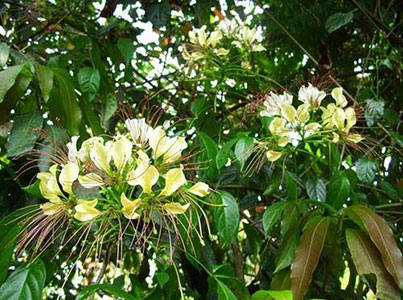
Description of Plant
Crataeva nurvala is a deciduous tree of medium size. It can grow to 50 feet high. The bark is smooth and brown in color and has horizontal wrinkles on it. Its branches have white patches with purple and yellow lines. Leaves grow up to 12 cm and its leaflets are oval in shape. Its leaves are trifoliate. It flowers in March and fruits in June. Its flowers are white and greenish in color. Crataeva’s fruits resemble lemon in shape. In India it is usually found near temples, planted for healing purposes.
Destructive harvesting and deforestation have endangered the survival of the plant. As a result of this endangered condition of this plant govt. have made this plant vulnerable and endangered.
Other Names of Crataeva Nurvala
It is known differently in various languages
- English Name – Three Leafed Caper
- Latin Name – Crataeva Nurvala Buch Ham-Pennel.
- Sanskrit Name – Varuna. It is named varuna(god of water) due to its action on body fluids and urinary system.
- Hindi Name – Varun
Which Family Does it Belong to?
Caparidaceae.
Habitat
Crataeva is found throughout India, especially along rivers and streams in sub-alpine zones. It grows well in wet soil with ph 7 and a good amount of sunlight. In India, it is found in Kerala, Madhya Pradesh, and Assam.
What is its Chemical Composition?
Varunol and triterpenoids are found in its roots and stem bark. Leaves consist of flavonoids including rutin, quercetin, and isoquercetin.
What is its Botanical Classification?
- Kingdom – Plantae
- Division – Spermatophyta
- Subdivision – Angiospermae
- Class – Dicotyledone
- Subclass – Polypetalae
- Order – Parietals
- Series – Thalamiflorae
- Family – Capparidacae
- Genus – Crataeva
- Species – Nurvula
- Scientific Name – Crataeva Nurvulua
Which part of this Plant is Used?
Root bark, stem bark, leaves, and flower.
What are its Medicinal Properties given in Ayurveda?
- RASA(Taste) – Bitter
- GUNA(Qualities) – Light to Digest, Dry.
- VIPAKA(Taste Conversion after Digestion) – Pungent
- VEERYA(Potency)- Hot
- Effect on Tridosha – Balances Kapha and Vata dosha.
What are it’s Therapeutic Uses?
The bark of this plant is being used for more than 3000 years in Ayurveda to treat various diseases. Bark and leaves of this plant are being used extensively for preparing herbal medicines.
- Crataeva nurvala is a high-value medicinal plant that grows almost all over India. Its medicinal usage has been listed in a various traditional medicinal system like Ayurveda.
- The bark of this plant is supposed to have many medicinal properties like anti-oxidant, anti-microbial, anti-inflammatory, renal support, and other supportive qualities.
- The roots have a laxative property and are a very good lithotripter, i.e. ability to break hard masses or stones.
- The leaves help in healing wounds and relieve stomach ache.
- It helps people with low appetite by improving digestion.
- It is a very good blood purifier.
- It promotes bile secretion.
- It is also anti- helminthic, eliminates worms from intestines.
- It lowers temperature in fever.
- It prevents liver infection as it acts as a liver tonic.
- It cures rheumatic pains.
- Researchers say that it has anti-arthritic, hepato-protective and cardio-protective properties.
- It is used to treat BPH as it has lupeol which reduces inflammation by neutralizing the enzyme called leukotrienes which is responsible for inflammation.
What is its Effect on Dosha?
According to Ayurveda, all the ailments are caused due to an imbalance of dosha. There are three doshas, Kapha, vata and pitta. Crataeva nurvala promotes pitta and pacifies Kapha and Vata.
What are its Effects on Kidney?
Crataeva is a valuable herbal remedy to treat various renal conditions, like
- Crataeva nurvala is a very wonderful herbal remedy to treat kidney stones as it has a litholytic action. It consists of lupeol, which deactivates the enzyme glycolate oxidase which decreases the production of oxalates in the body. Oxalates combine with calcium to form kidney stones. So it decreases the tendency to form kidney stones.
- It is a diuretic which hinders the formation of kidney stones.
- Its bark is very effective in treating urinary infections.
- It can be used for bladder sensitivity and prostate enlargement.
- It also treats urinary calculi, dysuria, and cystitis.
- It dilates superficial capillaries which stimulate effective circulation.
How is Used in Unani Medicine System?
Its bark is used for urinary troubles, improving appetite and decreases secretion of bile and phlegm.
How it is Used in Siddha?
In Siddha it is known as maralingam, its bark stimulates the liver and acts as a laxative and improve appetite.
Are there any Side-Effects of Crataeva Nurvala?
- Generally, there are no side-effects of this herb, but should always be taken under the guidance of the physician.
- In few cases blistering on the skin can occur when used as a topical application.
- If taking blood pressure medication medical advice is necessary as it has a diuretic property.
- Avoid using it during pregnancy. Otherwise safe to use during lactation and in children (should be taken under medical care)
How to Use it?
- Tea- 50ml two times a day.
- Topical leaf paste- one time a day, as directed by a physician
- Tincture-200 mg to be taken orally, twice a day.
